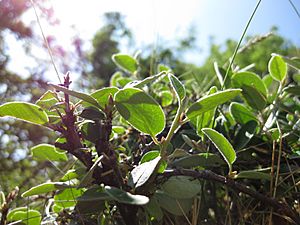Wild cotoneaster facts for kids
Quick facts for kids Wild cotoneaster |
|
|---|---|
 |
|
| Conservation status | |
| Scientific classification | |
| Genus: |
Cotoneaster
|
| Species: |
cambricus
|
The wild cotoneaster (scientific name: Cotoneaster cambricus) is a special plant found only in one place: the Great Orme peninsula in north Wales. In Welsh, it's called Creigafal y Gogarth, which means "rock apple of Gogarth." This makes it unique because it's the only type of cotoneaster plant that naturally grows in the British Isles. Scientists used to think it was the same as another plant, Cotoneaster integerrimus, but they later found out it's different when they looked at its genes.
Contents
About the Wild Cotoneaster
The wild cotoneaster is a deciduous shrub. This means it's a woody plant that loses its leaves every autumn. It can grow up to 1.5 meters (about 5 feet) tall and spread out to 2 meters (about 6.5 feet) wide.
Leaves and Flowers
Its leaves are shaped like ovals with a pointed tip. They are usually between 1 and 4 centimeters (about 0.4 to 1.6 inches) long. The top of the leaves is green with a few soft hairs. The underside and edges of the leaves have many white hairs, making them feel fuzzy.
The plant produces small flowers in early to mid-spring. These flowers grow in small clusters, usually with one to four flowers together. Sometimes, you might see up to seven flowers in a cluster. Each flower is tiny, about 3 millimeters (0.1 inches) across. They have five petals that are white or a light pink color.
Fruit and Seeds
After the flowers, the plant grows bright red fruit. These fruits are called pomes, like tiny apples. They are usually between 7 and 11 millimeters (about 0.3 to 0.4 inches) wide. Inside each fruit, there are two or three seeds. However, it's very hard for these seeds to grow into new plants naturally.
Protecting the Wild Cotoneaster
The wild cotoneaster is a critically endangered species. This means it's at a very high risk of disappearing forever. There are only six plants known to be growing naturally in the wild today. These few plants are not making new baby plants on their own.
Conservation Efforts
To help save this plant, scientists and conservationists are working hard. They have grown 11 more plants from cuttings and seeds. These plants were then planted back into the wild. However, it's a difficult process, as only 11 out of 33 planted plants survived.
There is a plan to increase the number of wild cotoneaster plants to 100 by the year 2030. Some plants are also grown in botanical gardens to keep them safe.
Why It's Endangered
When the wild cotoneaster was first discovered in 1783, there were many more plants on the Great Orme. Over time, its numbers dropped for several reasons:
- Plant Collectors: In the 1800s, people would dig up the plants to put them in their own gardens.
- Animals Eating Plants: Today, animals like sheep, wild goats, and rabbits eat the plants. This stops them from growing big, flowering, and prevents new seedlings from surviving.
- Competition from Other Plants: Other types of cotoneaster plants, which have escaped from nearby gardens, are growing in the wild. These new plants compete with the native wild cotoneaster for space and resources.
The wild cotoneaster is legally protected in the UK under the Wildlife and Countryside Act 1981. This law helps to prevent people from harming or collecting the plants.


